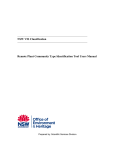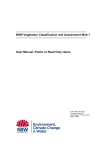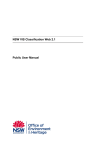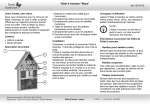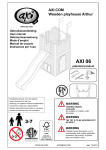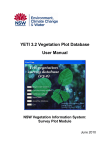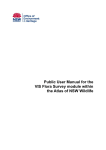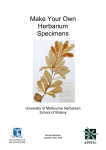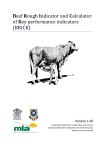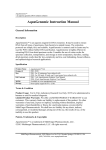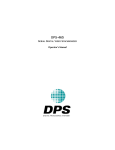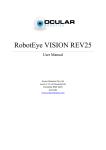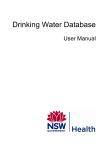Download now
Transcript
NSW VIS Classification (VCA Web 2.0) Public User Manual © 2011 State of NSW and Office of Environment and Heritage Disclaimer The Office of Environment and Heritage (OEH) has compiled this manual in good faith, exercising all due care and attention. No representation is made about the accuracy, completeness or suitability of the information in this publication for any particular purpose. OEH shall not be liable for any damage which may occur to any person or organisation taking action or not on the basis of this publication. Readers should seek appropriate advice when applying the information to their specific needs. This document may be subject to revision without notice and readers should ensure they are using the latest version. Published by: Office of Environment and Heritage 59 Goulburn Street, Sydney NSW 2000 PO Box A290, Sydney South NSW 1232 Phone: (02) 9995 5000 (switchboard) Phone: 131 555 (environment information and publications requests) Phone: 1300 361 967 (national parks, climate change and energy efficiency information, and publications requests) Fax: (02) 9995 5999 TTY: (02) 9211 4723 Email: [email protected] Website: www.environment.nsw.gov.au Report pollution and environmental incidents Environment Line: 131 555 (NSW only) or [email protected] See also www.environment.nsw.gov.au OEH 2011/0952 December 2011 TABLE OF CONTENTS 1. Introduction............................................................................................................. 4 2. Background ............................................................................................................ 4 2.1 What is the Vegetation Information System Classification? .............................. 4 2.2 Role of the OEH Vegetation Information Unit.................................................... 4 3. Possible Technical Issues ...................................................................................... 5 4. Registering as a Public User .................................................................................. 6 5. Opening the Database: Home Page....................................................................... 8 5.1 Links to Other Information................................................................................10 5.2 News & Bulletins ..............................................................................................11 6.0 Getting Data: Reports and Exports......................................................................12 6.1 Options For Searches (Exports and Reports) ..................................................13 6.2 Standard Reports (and Exports) ......................................................................16 6.2.1 Step 1: Choose Report Template ..............................................................16 6.2.2 Step 2: Select Communities. .....................................................................18 6.2.3 Step 3: Show results..................................................................................22 6.2.4 Step 4: Run report .....................................................................................22 6.2.5 Saving Report Criteria ...............................................................................24 6.3 Custom Reports ...............................................................................................25 6.3.1 Step 1: Select Report Template.................................................................26 6.3.2 Step 2: Select Communities ......................................................................27 6.3.3 Advanced options ......................................................................................30 6.3.4 Step 3: Show results..................................................................................31 6.3.5 Step 4: Run report .....................................................................................32 6.3.6 Saving Report Criteria ...............................................................................34 6.3.7 Customised Terms ....................................................................................35 7 Logging Out ............................................................................................................37 References ................................................................................................................38 Attachment 1: Possible Internet Explorer Issues .......................................................39 1. Introduction This manual is to provide support for Public Users in the operations of the New South Wales Office of Environment and Heritage’s (OEH) Vegetation Information System Classification Database (Vegetation Classification and Assessment Web Application version 2 – VCA2.0). It is presented as a step-by-step approach, with additional documentation to assist users provided as relevant, both from within this document and from the further information links provided in the web database pages. Throughout the document, boxed text (as used here) has been used to highlight issues for users to note, or to provide background information. Any queries with regard to this manual can be directed to: [email protected] 2. Background 2.1 What is the Vegetation Information System Classification? The Vegetation Information System Classification (VIS Classification) is the database for plant community types in New South Wales. The development of the classification database is an integral part of the NSW Vegetation Information System (NSW VIS), which aims to provide a single, integrated source for vegetation information in NSW. The aim of the NSW VIS Classification project is to produce a consistent hierarchical vegetation classification of New South Wales plant community types, and to provide public access to information on these plant community types. This version of the VIS Classification is a further development of the Vegetation Classification and Assessment (VCA) web enabled version released as VCA1.1. This further builds on the original NSW VCA system developed by the Royal Botanic Gardens Trust (RBGT), and published in the scientific journal Cunninghamia (Benson 2006; Benson, et al. 2006; Benson 2008; and Benson et al. 2010). The NSW Plant Community Type classification has been constructed by integrating two existing vegetation classification databases: the NSW Vegetation Classification and Assessment database developed by the RBGT; and the Over-cleared BioMetric Vegetation Types Database developed for used in Property Vegetation Planning and BioBanking assessment processes. By integrating this information into one system, VIS Classification establishes a single NSW Master Plant Community Type list as the focal point for both vegetation type mapping and regulatory assessment processes. Further background information on the development of the NSW vegetation Information System and its components can be found on the OEH web site: http://www.environment.nsw.gov.au/research/VegetationInformationSystem.htm 2.2 Role of the OEH Vegetation Information Unit The development of the NSW VIS is being coordinated by the Vegetation Information Unit within the Scientific Services Division of the NSW Office of Environment and Heritage. This unit is developing and supporting the NSW VIS and other native vegetation projects and programs as part of OEH’s strategic leadership of native vegetation information management. One of the key objectives for the unit, and the NSW VIS project in particular, is to ensure effective access to NSW VIS Classification (VCA Web 2.0): Public User Manual 14/12/2011 4 and appropriate use of, the full range of vegetation information for NSW, including plot, classification and mapping data and products. For further information on the role of the unit, the NSW VIS Project or OEH’s role in vegetation information, please contact the OEH Vegetation Information Unit ([email protected]). 3. Possible Technical Issues If you are using Microsoft’s Internet Explorer, pleased note that sometimes Internet Explorer may inhibit the retrieval of cached information. If during use you find that pages or areas are not refreshing as expected (eg clicking on options radio buttons does not clear previous selections), please refer to the information provided in Attachment 1 Possible Internet Explorer Issues. Also please note that to enable some functions, including producing reports, you may need to have the Pop Up Blocker turned off. In Internet Explorer, you can do this via the Tools menu, as shown below (two options, depending on the layout you have). Option 1: NSW VIS Classification (VCA Web 2.0): Public User Manual 14/12/2011 5 Option 2: 4. Registering as a Public User To register to use the VIS Classification, follow the link to the NSW VIS Classification Public User Registration page (http://www.environment.nsw.gov.au/NSWVCA20PRapp/LoginPR.aspx). This will open the page shown below. Click on New User Register Here hyper-link text to open the new user registration page. The Conditions of Use screen will appear: NSW VIS Classification (VCA Web 2.0): Public User Manual 14/12/2011 6 : Please read the conditions, then click to accept the conditions if you wish to proceed. The Register button will now become active; click to open the registration screen, as shown below. Fill in the required details as indicated for each field. Please note that no spaces are allowed in the phone number field. NSW VIS Classification (VCA Web 2.0): Public User Manual 14/12/2011 7 Please note that you will not be able to change your password once it is registered, so please ensure you will be able to recall your password when needed. If you forget your password, a retrieve password link is provided on the log in page. Once you are registered in the system you will be automatically directed to the VIS Classification Home Page. You will also receive an email (to the email address you provided) noting your registration and with details of your user name and password. Please keep a copy of this email for future reference. Please take normal security measures with regard to your user name and password. 5. Opening the Database: Home Page To open the VIS Classification application, you will need to log into the system via the link below: http://www.environment.nsw.gov.au/NSWVCA20PRapp/LoginPR.aspx NSW VIS Classification (VCA Web 2.0): Public User Manual 14/12/2011 8 This opens the log in screen shown below. Please enter your network log in user name and password (see Section 3 Possible Technical Issues, above), then click the ‘log in’ button to open the NSW Vegetation Information System Classification Home Page. While you are on the Home Page, please note the time counter at the top right hand corner of the screen, as indicated below. NSW VIS Classification (VCA Web 2.0): Public User Manual 14/12/2011 9 This counts down from 60 minutes to zero – this is the amount of time remaining before the system will log you off if there has been no page activity. When the counter gets down to less than 1 minute, the warning message below will appear: This counter will reset whenever you activate anything on a page or move across pages. You can also reset the time by clicking the ‘Reset’ button which will set the timer back to 60 minutes. 5.1 Links to Other Information On the top right of the Home Page there are a number of links that provide further background or related information, as shown below. Please note, however, that these will navigate you away from the VIS Classification Home Page. You can choose to open the new links in either a new tab on your browser, or in a new browser page by right clicking on the relevant link. This opens the drop down menu as shown below. NSW VIS Classification (VCA Web 2.0): Public User Manual 14/12/2011 10 Simply select the option for how you want the new link page to open by clicking on that option in the list. 5.2 News & Bulletins From the home page, click on the ‘News & Bulletins’ tab, as shown below. NSW VIS Classification (VCA Web 2.0): Public User Manual 14/12/2011 11 This will open the list of topics currently listed as News and Bulletins, as shown below. This area provides summaries of any important notifications and alerts in relation to major changes to plant communities types or the database itself, including decisions by the Plant Community Type Change Control Panel and general information of system changes. Links may be provided to more further information. 6.0 Getting Data: Reports and Exports To export data or produce reports of data for plant community types (PCTs), choose the Reports/ Exports option from the drop down menu under the Communities blue tab, as shown below. NSW VIS Classification (VCA Web 2.0): Public User Manual 14/12/2011 12 Clicking on the Reports/ Exports menu item opens the screen below. Please read the information at the beginning of the search page, and in the following sections to understand the nature and limitations of search options for both exporting and reporting data. 6.1 Options For Searches (Exports and Reports) Only some fields in the VIS Classification database have been fully populated for all plant communities (see below). The fully populated fields are suitable for state-wide searches, and will return a complete list search result. Search using these fields only if you require a comprehensive list of available plant community types, ie all plant community types across the state that match your search query. The list of the fully populated fields is: NSW VIS Classification (VCA Web 2.0): Public User Manual 14/12/2011 13 • Plant Community Type ID • Biometric Vegetation Type ID • Common name • Scientific name • Vegetation Class (Keith 2004) • Vegetation Formation (Keith 2004) • Catchment Management Authority (CMA) • Upper Stratum Species • Mid-story stratum species • Ground stratum species • PCT Listing Status • Dominant canopy species • Main associated species • Landscape position • Other diagnostic features • Cleared estimate (% of CMA cleared) • Threatened Ecological Communities (TEC) Listed communities • Community Benchmark data • References The remaining fields in the VIS Classification database are incomplete so searches may retrieve only partial results of plant community types. In particular, the data for plant community types along the eastern ranges and coastal areas of NSW is restricted, and there may be no data in any fields other than the state-wide fields listed above. If this is your area of interest, you are advised to use the State-wide Search above. The coverage for the western portions of the state is good, so if your area of interest is in these regions, you can search using the full range of fields available. The data coverage map in Figure 1 shows the area covered by the full list of fields. If you want to undertake a search using the additional fields, aware of the potential limitations on results, you can use the Full Field Search option. NSW VIS Classification (VCA Web 2.0): Public User Manual 14/12/2011 14 Figure 1. Current coverage of full data fields in VIS Classification (CMA over IBRA bioregional boundaries). Comprehensive data is only available for the green region. Only the western portion of the New England Tablelands (orange region) is fully covered. Only state-wide searches (ie searches restricted to using state-wide fields) will ensure retrieval of all communities in the pink region and the eastern portion of the New England Tablelands NSW VIS Classification (VCA Web 2.0): Public User Manual 14/12/2011 15 Please click on the hyper-linked text to the Report and Export Search Options on the search page for further information. For both options, you will be able to further choose Standard or Custom Reports or Exports. Standard Reports provide a quick means to export data or produce a report via a set of templates. Further information on the types of templates available is provided via the hyper-link to the What’s In The Reports? On the search page. The Custom Reports and Custom Exports options enable you to further design your reports and exports via a larger set of query terms and the ability to select which fields will be displayed or produced. Once you have chosen an option, please choose whether you want a Standard Report or export, or if you wish to customise your search, choose a Custom Report or export. NB: As the search routines are the same whether you are looking to export data or produce a report the following instructions apply to both. Please refer to the Standard Report Guide or the Custom Report Guide as relevant for further information for either exports or reports 6.2 Standard Reports (and Exports) Select the Standard Reports option to open the page shown below. The steps to produce a Standard Report are provided below. 6.2.1 Step 1: Choose Report Template Select the report template you want from the drop down menu, as shown below. NSW VIS Classification (VCA Web 2.0): Public User Manual 14/12/2011 16 Information on the report templates is available via the ‘What’s in the reports?’ hyper-linked text on the search page (under the template selection field). If you are exporting, there will be an option to ‘Export all PCTs’ (ie export all plant community types), as shown below. This option will export all fields in the standard for all listed plant community types. When the Template is selected, the relevant fields for the selected report template will be loaded into the ‘Select communities by’ field boxes below, as shown below (example below is for the Long without ref text (VCA Format) template). NSW VIS Classification (VCA Web 2.0): Public User Manual 14/12/2011 17 6.2.2 Step 2: Select Communities. Select a criteria by clicking the check box next to the field name you want to add, as shown below (using ‘Class (Keith Class)’ as the example): When you have selected a field, click ‘Add’ to add it to the search criteria. This opens the Search condition page as shown below. NSW VIS Classification (VCA Web 2.0): Public User Manual 14/12/2011 18 Click on the ‘Operator’ drop down menu to view and select the options. These will vary according to the type of data in the relevant field. Options are shown in the sequence below: Text based fields: Numeric fields: Look up Tables fields: NSW VIS Classification (VCA Web 2.0): Public User Manual 14/12/2011 19 When you have selected the operator, select the attribute value from the drop down menu next to the field, as shown below. Select the term you want by clicking once on the relevant entry. When you have selected the term you want, select the type of operator you want applied for this criterion, either ‘Any (Or)’ or ‘All (And)’, as shown below. If you are using only one criterion, this term is not relevant. NSW VIS Classification (VCA Web 2.0): Public User Manual 14/12/2011 20 Please note that the ‘Select records for’ terms operate between the criteria, so that selecting ‘Any (or)’ will include communities that meet either of the criteria, while ‘All (And)’ will include only communities that meet both criteria simultaneously. For example, for criteria of Common Name contains gum and Class (Keith Class) = Alpine Heaths, the operator ‘Any (Or)’ will retrieve all communities where ‘gum’ occurs in the Common Name field, in addition to all communities where the Class (Keith Class) field is Alpine Heaths. This will retrieve hundreds of communities. Using the ‘All (And)’ operator however will select only those communities where the Common Name contains ‘gum’ AND where the ‘Class (Keith Class)’ is Alpine Heaths. In this case, no communities are retrieved as no communities match BOTH criteria. Please also note that the order of criteria is crucial to getting the result you want, as the first criteria creates a subset that the second criteria is matched to. Using the same criteria and swapping their order can therefore produce different results. When you have selected the term and operator, click ‘OK’ - the Search condition screen should now show your choices, as shown below. Continue to build your criteria by selecting the field, then ‘Add’ it to open the Search condition page for each field. You may edit or delete a criteria at any time by using the ‘Edit criteria’ or ‘Delete criteria’ options to the right. NSW VIS Classification (VCA Web 2.0): Public User Manual 14/12/2011 21 Handy Hint: As you compile criteria, please check the ‘Run’ button in Step 6 at the bottom of the screen. This in effect previews whether the current combination of criteria match at least one plant community type. If the ‘Run’ button is greyed out, there are no plant community types that meet the current combination of criteria. If this is the case, clicking ‘Show’ will retrieve no matches, so you will need to alter the criteria. 6.2.3 Step 3: Show results When you are happy with your criteria selection, click the ‘Show’ button. This opens a list of the plant community types that are matched to your criteria, as shown below. By default, all the matching types are shown checked, ie they will be in the report. You may need to scroll down the page to see the full list of communities. To modify, either uncheck individual communities in the list, or uncheck the top check box next to the VCA ID column header to deselect all communities. You can then reselect any by clicking individual communities or recheck all. When you are happy with the plant community types selected, click ‘OK’ to save these as the ones to be run in the report. Click ‘Close’ if you don’t want to save your changes. Please note however that this will revert back to the default position, ie all communities will appear in the report. 6.2.4 Step 4: Run report When you are ready, click ‘Run’ to produce the report. Please note that depending on the size of the report (ie number of communities selected and number of fields/columns to be displayed) this may take some minutes. When the system and server have processed the request, the report will be displayed on screen in a separate window, as shown below. (If you are exporting, details are immediately below the report description below). NSW VIS Classification (VCA Web 2.0): Public User Manual 14/12/2011 22 NB: The preview of reports appears as a new pop up screen. For this to function, please ensure that ‘block pop ups’ is not turned on; please refer to Section 3. Possible Technical Issues, above, for instructions how to turn of the pop ups block. You can review the report in this screen, then close it if you don’t want to save or print the report, or elect to save or print via the two icons in the top left hand corner of the report screen (as shown below.) NSW VIS Classification (VCA Web 2.0): Public User Manual 14/12/2011 23 Run – Exports If you are exporting, then when you click Run, the following pop up will appear: Click ‘Download CSV file’ to save the export file. The dialogue for saving as shown below will appear. Clicking ‘Close’ will cancel the operation. Please Open or Save the file as relevant. ‘Cancel’ will Cancel the operation, but the Download CSV dialogue box will remain. 6.2.5 Saving Report Criteria Once you have created your search, you can save the search set up to retrieve and run later, thus obviating the need to create the search again. To do this, give the current search set up a name in the ‘Name your search’ box on the right, then click ‘Save’. This will save the set up to your log in, ie only you have access to this saved search. To retrieve the saved search, select it from the ‘Load a saved search’ box in the top right, by selecting it from the list and clicking once on the relevant saved search, as shown below. NSW VIS Classification (VCA Web 2.0): Public User Manual 14/12/2011 24 This will automatically populate the fields for the search as they were saved to that name. To modify an existing saved search, retrieve and load it, make your changes then save it using the same name. This will overwrite the existing saved set up. You can create multiple saved searches, but remember to change the saved name if you do not want to overwrite an existing saved search. 6.3 Custom Reports Select the Custom Reports option: This will open the page shown below. NSW VIS Classification (VCA Web 2.0): Public User Manual 14/12/2011 25 The steps to produce a Custom Report are provided below. 6.3.1 Step 1: Select Report Template. Information on the report templates is available via the ‘What’s in the reports?’ hyper-linked text. Please note however, that this document only refers to the five ‘VCA Format’ reports. When the Template is selected, the relevant fields for the selected report template will be loaded into the ‘Select communities by’ field boxes below, as shown below (example below is for the Long without ref text (VCA Format) template). Also note that the appropriate list of fields will be populated into the ‘Advanced options’ area at the bottom of the page. NSW VIS Classification (VCA Web 2.0): Public User Manual 14/12/2011 26 By default, the selection will show the ‘common terms’ option, with all fields unchecked. 6.3.2 Step 2: Select Communities There are two ways to compile your search query, ie criteria that the system will use to retrieve the relevant plant community types. By default, the ‘common terms’ method is active. This method presents a subset of the total number of fields and tables in the database, representing the most commonly used terms. Please scroll down the list to see what fields are available. NSW VIS Classification (VCA Web 2.0): Public User Manual 14/12/2011 27 When you are ready, please check one of the Column boxes, as shown below. The ‘Add’ button should now become active, ie no longer greyed out. Click the ‘Add’ button to add the selected criteria to the open the Search condition page as shown below. Click on the ‘Operator’ drop down menu to view and select the options. These will vary according to the type of data in the relevant field. Options are detailed in 6.2.2 Step 2: Select Communities, above. When you have selected the operator, select the attribute value from the drop down menu next to the field, as shown below. NSW VIS Classification (VCA Web 2.0): Public User Manual 14/12/2011 28 Select the term you want by clicking once on the relevant entry. The Search condition screen should now show your choices. Select the type of operator you want applied for this criterion, either ‘Any (Or)’ or ‘All (And)’, as shown below. If you are using only one criterion, this term is not relevant. NSW VIS Classification (VCA Web 2.0): Public User Manual 14/12/2011 29 Please note that the ‘Select records for’ terms operate between the criteria, so that selecting ‘Any (or)’ will include communities that meet either of the criteria, while ‘All (And)’ will include only communities that meet both criteria simultaneously. For example, for criteria of Common Name contains gum and Class (Keith Class) = Alpine Heaths, the operator ‘Any (Or)’ will retrieve all communities where ‘gum’ occurs in the Common Name field, in addition to all communities where the Class (Keith Class) field is Alpine Heaths. This will retrieve hundreds of communities. Using the ‘All (And)’ operator however will select only those communities where the Common Name contains ‘gum’ AND where the ‘Class (Keith Class)’ is Alpine Heaths. In this case, no communities are retrieved as no communities match BOTH criteria. Please also note that the order of criteria is crucial to getting the result you want, as the first criteria creates a subset that the second criteria is matched to. Using the same criteria and swapping their order can therefore produce different results. Click OK to retain the criteria. The selected criteria should now appear in the field box to the right, as shown below. You can delete or edit the criteria in this compiling area by clicking on the ‘Edit criteria’ or ‘Delete criteria’ text. The ‘Edit criteria’ option will take you back to the Search condition screen with the current criteria shown. The ‘Delete criteria’ will remove that criteria entirely from the compiled list. Handy Hint: As you compile criteria, please check the ‘Run’ button in Step 6 at the bottom of the screen. This in effect previews whether the current combination of criteria match at least one plant community type. If the ‘Run’ button is greyed out, there are no plant community types that meet the current combination of criteria. If this is the case, clicking ‘Show’ will retrieve no matches, so you will need to alter the criteria. 6.3.3 Advanced options The ‘Advanced options’ area at the bottom of the screen provides additional functionality to (i) choose to produce or not produce images in the report, and (ii) choose which fields will be displayed in the report. NSW VIS Classification (VCA Web 2.0): Public User Manual 14/12/2011 30 Images options Simply choose the option required under ‘Choose image options’ ie Yes to have images, No to not have images. Please note this option only applies to reports that have images in their template, eg long reports do, simple list of communities does not. If the template you choose does not have images, then this does nothing. Fields to display The ‘Choose fields for report’ are provides a list of the fields currently set to be produced in the report. By default, all the fields are checked as ‘on’ as all fields in the template will be produced. You can simplify your report by turning off any number of fields. The fields are arranged according to the tables within the template. You can turn individual fields off (and back on) or turn off (and back on) all fields in the table, as shown below. Turn off all fields in this group Turn off just this field As you alter the display fields, the ‘Fields that will be displayed’ box on the right will refresh to reflect the changes. 6.3.4 Step 3: Show results When you are happy with your criteria selection, click the ‘Show’ button. This opens a list of the plant community types that are matched to your criteria, as shown below. NSW VIS Classification (VCA Web 2.0): Public User Manual 14/12/2011 31 By default, all the matching types are shown checked, ie they will be in the report. You may need to scroll down the page to see the full list of communities. To modify, either uncheck individual communities in the list, or uncheck the top check box next to the VCA ID column header to deselect all communities. You can then reselect any by clicking individual communities or recheck all. When you are happy with the plant community types selected, click ‘OK’ to save these as the ones to be run in the report. Click ‘Close’ if you don’t want to save your changes. Please note however that this will revert back to the default position, ie all communities will appear in the report. 6.3.5 Step 4: Run report When you are ready, click ‘Run’ to produce the report. Please note that depending on the size of the report (ie number of communities selected and number of fields/columns to be displayed) this may take some minutes. When the system and server have processed the request, the report will be displayed on screen in a separate window, as shown below. NSW VIS Classification (VCA Web 2.0): Public User Manual 14/12/2011 32 NB: The preview of reports appears as a new pop up screen. For this to function, please ensure that ‘block pop ups’ is not turned on; please refer to Section 3. Possible Technical Issues, above, for instructions how to turn of the pop ups block. You can review the report in this screen, then close it if you don’t want to save or print the report, or elect to save or print via the two icons in the top left hand corner of the report screen (as shown below.) NSW VIS Classification (VCA Web 2.0): Public User Manual 14/12/2011 33 Run – Exports If you are exporting, then when you click Run, the following pop up will appear: Click ‘Download CSV file’ to save the export file. The dialogue for saving as shown below will appear. Clicking ‘Close’ will cancel the operation. Please Open or Save the file as relevant. ‘Cancel’ will Cancel the operation, but the Download CSV dialogue box will remain. 6.3.6 Saving Report Criteria Once you have created your search, you can save the search set up to retrieve and run later, thus obviating the need to create the search again. To do this, give the current search set up a name in the ‘Name your search’ box on the right, then click ‘Save’. This will save the set up to your log in, ie only you have access to this saved search. To retrieve the saved search, select it from the ‘Load a saved search’ box in the top right, by selecting it from the list and clicking once on the relevant saved search, as shown below. NSW VIS Classification (VCA Web 2.0): Public User Manual 14/12/2011 34 This will automatically populate the fields for the search as they were saved to that name. To modify an existing saved search, retrieve and load it, make your changes then save it using the same name. This will overwrite the existing saved set up. You can create multiple saved searches, but remember to change the saved name if you do not want to overwrite an existing saved search. 6.3.7 Customised Terms The alternative approach to selecting communities for your reports or export is to customise the terms or criteria that are used in building your search query. To do this, click the radio button next to the ‘customised terms’ option at Step 2, as shown below. NSW VIS Classification (VCA Web 2.0): Public User Manual 14/12/2011 35 The list of fields directly below will refresh to display the full list of fields available to create your query. Please note that there are almost 200 fields in total so setting up your query may be time consuming. However you will be able to save and retrieve your query as part of a saved search once you have created it. The fields initially are collapsed within the tables that the fields belong to. To see the fields, click the ‘+’ symbol next to the category ( table or field grouping) to expand it, as shown below. The process for selecting the terms is the same as described above in Section 20.1.2 Step 2 Select Communities above. Please refer to that section for instructions for building your query. You can collapse a category at any time by clicking on the’ –‘ symbol against an open category menu. Definitions of the table categories (ie ‘terms’) and fields is provided via the hyper-linked ‘Descriptions of Terms (Tables and Field Definitions)’. NSW VIS Classification (VCA Web 2.0): Public User Manual 14/12/2011 36 7 Logging Out When you have finished your VIS Classification session, please remember to log out of the application by clicking the ‘LOGOUT’ tab. NSW VIS Classification (VCA Web 2.0): Public User Manual 14/12/2011 37 References Benson, J.S. (2006) New South Wales Vegetation Classification and Assessment: Introduction the classification, database, assessment of protected areas and threat status of plant communities. Cunninghamia 9(3): 331-382. Benson, J.S., Allen, C., Togher, C. & Lemmon, J. (2006) New South Wales Vegetation Classification and Assessment: Part 1 Plant communities of the NSW Western Plains. Cunninghamia 9(3): 383-451. Benson, J.S. (2008) New South Wales Vegetation Classification and Assessment: Part 2 Plant communities in the NSW South-western Slopes Bioregion and update of NSW Western Plains plant communities. Version 2 of the NSWVCA database. Cunninghamia 10(4): 599-673. Benson, J.S., Richards, P., Waller, S. & Allen, C. (2010) New South Wales Vegetation classification and Assessment: Part 3 Plant communities of the NSW Brigalow Belt South, Nandewar and west New England Bioregions and update of NSW Western Plains and Southwestern Slopes plant communities, Version 3 of the NSWVCA database. Cunninghamia 11(4). Forestry Commission of New South Wales (1989) Forest types in New South Wales. Research Note 17 (Forestry Commission of New South Wales: Pennant Hills). IUCN (The World Conservation Union) (2001) IUCN Red List Categories: Version 3.1 Prepared by the IUCN Species Survival Commission (IUCN: Gland, Switzerland and Cambridge). Keith, D.A. (2004) From ocean shores to desert dunes: the vegetation of New South Wales and the ACT (Department of Environment and Conservation NSW: Hurstville). Mitchell, P.B. (2002) NSW Ecosystems study: background and methodology. Report 13.7 NSW Biodiversity Strategy (NSW Department of Environment and Conservation: Sydney). New South Wales Department of Environment and Conservation (2004) IBRA sub-regions. Unpublished GIS map (NSW DEC: Sydney). Walker, J. & Hopkins, M.S. (1990) Vegetation. In McDonald, R.C., Isbell, R.F., Speight, J.G., Walker, J. & Hopkins, M.S. (1990) Australian soil and land survey: field handbook (Inkata Press: Melbourne). NSW VIS Classification (VCA Web 2.0): Public User Manual 14/12/2011 38 Attachment 1: Possible Internet Explorer Issues There is a known issue with IE in that the retrieval of cached information may over-ride the loading of updated pages. If during use you find that pages or areas are not refreshing as expected (eg clicking on options radio buttons does not clear previous selections), this may be due to cache retrieval. To fix this, select the ‘Internet Options’ from the Tools menu in IE, as shown below. The screen below should appear: Click on ‘Settings’ in the Browsing history’ section. This opens the screen below: NSW VIS Classification (VCA Web 2.0): Public User Manual 14/12/2011 39 Ensure that the ‘Automatically’ radio button is checked, as shown above (NB note what the current option is so you can reset if you wish after UAT). Click OK to go back to the Internet Options screen. Now click on the ‘Delete’ button in the ‘Browsing history’ section. The options screen below should appear. Click on ‘Delete files…’ in the ‘Temporary Internet Files’ section. This will delete only the stored temporary files. Please note that if you haven’t cleared the temporary files for a while (or ever!) this may take some time. A progress screen will show while this is happening. Provided the green bar keeps moving, all should be fine. It may also be advisable to delete the cookies from the IE cache (ie click ‘Delete cookies…’ in the ‘Cookies’ section). This will remove all stored data that is retrieved by a range of sites, including stored log in information. This simply means that if you clear the Cookies, you will need to provide log in data when you return to any page that was using stored log in NSW VIS Classification (VCA Web 2.0): Public User Manual 14/12/2011 40 information. There shouldn’t be any issues with this, but if you are unsure, please ignore this step. When the processes are finished, click ‘Close’, then ‘Cancel’ at the next screen to return to the VIS Classification screen. NSW VIS Classification (VCA Web 2.0): Public User Manual 14/12/2011 41









































